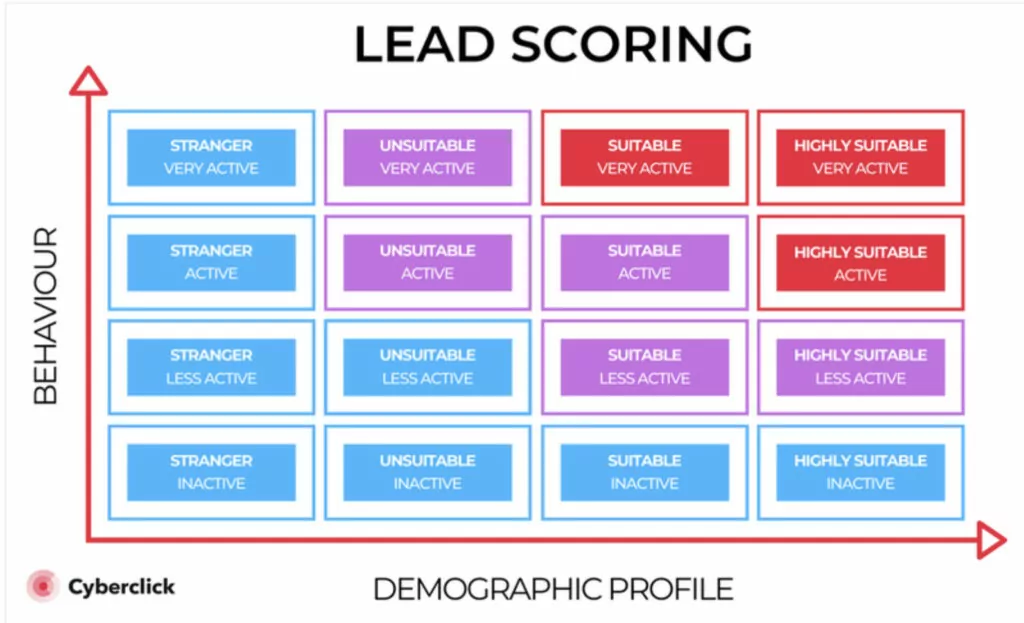If you chased every lead that came your way, you would spend hours on consumers with no interest in your products and services. That is not an effective way to grow your business and only wastes resources. Instead, maximize your marketing and sales efforts by sorting leads according to their value and interest through a customized lead scoring model.
Learn five steps for building a lead scoring model that matches your business goals and increases your conversion rate for higher profits.
Key Takeaways:
- Lead scoring assigns value to every visitor action and attributes to rank them according to their likelihood of conversion.
- Large businesses need several lead scoring models unique for each service and customer persona.
- The most effective models will involve your sales team, marketing team, and customers.
What is Lead Scoring and Why Is It Important?
Over 65% of marketers say generating traffic and leads is their greatest challenge. However, the traffic you generate isn’t always ready or willing to buy. About 96% of the visitors to your website aren’t going to make a purchase right away.
Lead scoring sorts through your visitors and prospects and identifies those most likely to purchase in the future. To create a lead scoring model, you assign value to consumer actions and attributes that rank those leads according to their likelihood of buying a product.
When you prioritize the leads ready to buy, you can spend extra resources on lead nurturing for high-value prospects and increase your chances of a conversion for a greater ROI.
Source: Salesforce
Types of Lead Scoring Models
The larger your business is, the more lead scoring models you need to cover your buyers’ different behaviors and characteristics. Here are three types of models to consider for your lead scoring marketing strategies.
Fit vs. Interest
Scoring your leads based on their fit will tell you how well they match your buyer persona. This can help you identify accounts for an account-based marketing strategy. When you score by interest, you gauge how likely they are to buy based on their behavior.
Many models combine both scores, with leads that rank high in fit and interest being the highest value targets.
Source: The Blueprint
Lead Scoring for Different Personas
You will have different scoring models for each customer persona you created. For example, your B2B customers exploring enterprise-level products will show vastly different behaviors than a B2C customer interested in your other products.
Separating leads by product interest also helps you route your leads to the most qualified sales representatives.
Returning Customers
Your returning customers have great potential for upgrading or cross-selling. However, since they already understand your business and purchased products, they may not rank well on traditional lead scoring models and require an amended model built around repeat customer behaviors.
5 Steps to Build Your Own Lead Scoring Model
Use these five steps and lead scoring best practices to build your customized models around each service and franchise location’s needs and goals.
Step 1: Involve Your Sales and Marketing Teams
Your lead scoring model should be a combined effort from marketing, sales, and customers. Every team has valuable data from their interactions to help you make more accurate lead scoring models. When these teams collaborate, they can increase their closing rates by 30% using a united lead scoring model.
Your marketing team will know insights about what marketing materials bring the most leads or yield a good return. Your sales team can add their perspective about what content interactions or behaviors are common among leads that they convert.
For example, they can say that most customers that read a particular eBook usually purchase the connected service.
Contacting your customers and asking them for their feedback will provide insights into what content prompted them to act.
Step 2: Assign Demographic and Firmographic Scoring Factors
Marketing and sales will work together to create a list of common demographic or firmographic attributes among customers. The characteristics with the highest conversion rate will be assigned the most points. Over half of your leads will not fit your buyer attributes, so scoring based on these factors will filter those leads out.
Some lead scoring examples include:
- Business size and industry
- Budget
- Location
- Demographics
- Seniority or role
Step 3: Assign on Action-Based Scores
Lead behavior is also known as implicit scoring. These scores tell you how interested the lead is in your products or business and pinpoints specific services they are considering.
For example, 54% of sales representatives say most conversions start with social media engagement. That insight might prompt you to score social media interactions highly.
Some other examples of implicit scoring behaviors include:
- Pageviews
- Searches
- Clicks on emails, social media, or website links
- Downloads or sign-ups
- Content interactions
Analytic reports will help you assign more accurate lead scores by connecting customer behavior with conversion rates.
Step 4: Subtracting Points
Lead scoring isn’t only about adding positive points. Sometimes you will need to subtract points to balance your lead scoring model. Negative scoring weeds out quality leads that will not purchase, like someone who unsubscribes, visits your career page or comes from a competing organization.
An inactive lead can lose points depending on how long they remain stagnant, with the chance to rise again if they start engaging with your content and business again.
Negative scores also identify spam. For example, a large business that uses a Gmail account is a red flag. Have your marketing and sales team collaborate for this step and list out other common red flags they encounter.
Step 5: Lead Scoring Threshold
When you assign your points, you must decide what score is your lead scoring threshold. This is the point value when a lead is sales-ready. Lead scoring in CRM platforms will notify you once a lead reaches this threshold so your sales team can take immediate action.
You will then distribute your leads according to their specific scoring model to ensure the best-fitting representatives reach out to them. For instance, you can distribute leads according to the nearest franchise location or product interest.
Stop Wasting Time on Dead-End Leads
You don’t have to build your lead scoring model from manual calculations and guesses. Use our automation platform for tracking, scoring, and sending leads. Our machine learning model will save you time and increase your return on investment as you see more leads turn into conversion in a shorter time.
Schedule a demo and never lose another quality lead again.
Feature Image: istockphoto









